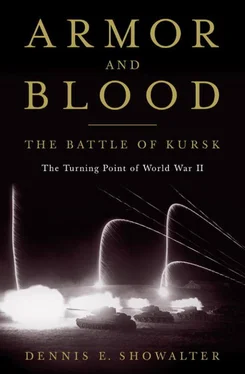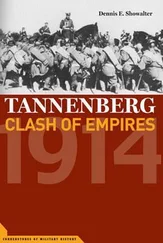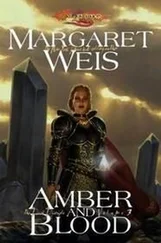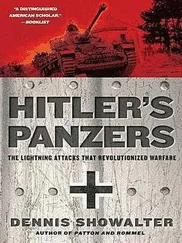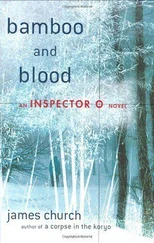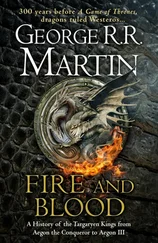For the men in the Red Army’s ranks, the war’s second summer seemed to offer “neither victory nor hope.” Another third of a million men, another two thousand tanks, had been lost. The survivors were caught up in what seemed an endless retreat across the steppes, broken by last stands on temporary stop lines. Sergey Bondarchuk, himself a veteran of four years’ wartime service, presented a sanitized dramatization in his 1975 epic film, They Fought for Their Country . It follows the remnants of a shattered rifle regiment as they make their way toward the Don and Stalingrad, facing the scorn of the civilians they abandon and wondering why their efforts so far have been so futile, until finally they turn and fight, unfurling their banner and following it to glory on the Volga.
The film’s tone of determined optimism interspersed with bits of comedy and nostalgia parallels that of its Western counterparts of the 1940s and 1950s in that it reflects an official policy that endured virtually until the Soviet Union’s final implosion. Russia’s soldiers and Russia’s people behaved heroically. Should they not in fact live up to the trope—that was why the police system existed, and from privates to generals, all went in fear of the NKVD. Its presence was ubiquitous, but its behavior remained random until July 28, when Stalin issued Order No. 227, which called for an end to retreat and demanded that every foot of Soviet soil be defended. Penalties ranged from service in a penal battalion to summary execution: more than 150,000 Red Army soldiers were formally sentenced to death. The number of summary executions will never be known.
High morale was a soldier’s duty, not his right. But Stavka did not base morale on executions alone. Part of the mythology of Soviet recovery from Barbarossa involves Stalin’s willingness to call on religion and nationalism. Orthodox prelates met with Stalin himself. Churches were opened, seminaries authorized. Accompanying this was a near cultic emphasis on the “motherland,” its heroes and its symbols. Motherland became a form of “sacred space,” combining emotional abstraction with geographic reality. Films and lectures celebrated legendary generals such as Bohdan Khmelnytsky, Aleksandr Suvorov, Mikhail Kutuzov—and Stalin, revolutionary defender of the city that now bore his name. Uniforms were smartened up with shoulder boards and standing collars. Military bling returned to fashion: a structure of medals, orders, and decorations that could literally cover the entire chest of senior officers such as Zhukov and his counterpart and rival, Ivan Konev. Enlisted men from cooks to snipers had their own badges recognizing “distinguished” service.
As early as September 1941, the title of “Guards” was reintroduced. Not Red Guards, as might have been expected—just Guards, referring both to the revolutionary formations and to the elite troops of the czarist empire. Units from independent battalions to entire armies that distinguished themselves in combat were rechristened and renumbered. Members of the units were titled Guardsmen—and the honorific accompanied them if they were transferred.
The new spectrum of recognitions was welcome enough. But for the surviving veterans of 1941, for the wartime conscripts, and for the recovered wounded returning in increasing numbers, the sting of defeat was beginning to mask the cultures of buck passing and scapegoating developed under two decades of postrevolutionary terror. The material and human devastation left in the Nazis’ wake had become general knowledge. For some in the ranks, it generated anger at losing the results of generations of sacrifice and deprivation. The impulse to spiral into nihilism was counterbalanced by a growing conviction, even among the cynical and the disaffected, that nothing was wrong with the Soviet Union that the Germans could fix—or wanted to.
A comprehensive and enduring propaganda campaign worked tirelessly to encourage and systematize hate—to make killing Germans a pleasure and a habit. Training, never exactly a humanitarian enterprise in the Red Army, inculcated toughness by such exercises as having tanks drive over recruits in slit trenches—sometimes trenches they had dug themselves. An “accident” or two was a sovereign cure for reluctance to dig in and dig deep.
A common Red Army type never developed even in the homogenizing context of total war and despite an official Soviet policy of stressing the collective nature of its sacrifice and victory. Age and ethnicity, background and culture, sustained individual identities. Confidence and comradeship, hope of recognition and fear of punishment, ideology and tradition—all played roles in renewing and refocusing combat motivation. Underpinning them all, even at the war’s middle stage, was the frontline soldiers’ increasing hope that their sacrifices would bring about postwar reform—“communism with a human face,” purged of prewar hatreds and misunderstandings, productive capacities adjusted to civilian needs and wants, leaders and people committed to the same goals.
Boris Gorbachevsky, by then a captain, recalls a postwar discussion with half a dozen of his men around the kind of campfire that inspired swapping confidences even with an officer present: “If only the authorities would give us freedom, spare us from Kolkhoz troubles and think up something like the NEP. If only they’d set us free, we could rebuild all of Russia within five years.” Illusion and delusion were not Third Reich monopolies.
The Red Army’s background is best understood in the context of disconnects: between the party and the military, and among the major combat arms. The German army of 1943 is best understood in terms of synergies: among army, party, and society and within the army’s fighting components.
The Nazi Party has been compared by scholars with almost every possible human organization, even medieval feudalism. The one adjective that cannot be applied is “patriarchal.” Change and progress were the movement’s flywheels. Nazi nostalgia found its essential expression in domestic kitsch. It had no place in military matters. Hitler’s initially enthusiastic wooing of the soldiers was based on his intention of using them first to consolidate his hold over both the Nazi Party and the German people, then as the standard-bearers of territorial and ideological expansion until they could safely be replaced by the SS. National Socialist views of war differed in important, arguably essential, respects from those of the Reichswehr. But on such subjects as anti-Marxism, anti-pacifism, and hostility to the Versailles Treaty, the military’s values were not incongruent with those avowed by Nazi theorists and propagandists.
The armed forces and the Nazis also shared a common commitment to the future rather than a vision of the past. General Hans von Seeckt during the Great War had established a reputation as one of the army’s most brilliant staff officers. He became head of the Reichswehr high command in the newly established Weimar Republic. From the beginning, he challenged the concept of mass that had permeated military thinking since the Napoleonic Wars, instead insisting on the principle of pursuing quick, decisive victories by offensive action.
Boldness was Seeckt’s first rule; flexibility was his second. The Treaty of Versailles, however, specified the structure of the Reichswehr in detail: a force of one hundred thousand, but, forbidden tanks, aircraft, and medium or heavy artillery, it badly needed force multipliers. Versailles did authorize each Reichswehr division a motor-transport battalion, and Seeckt saw their vehicles as an increasingly valuable supplement to the conventional combat arms. Beginning in the early 1930s, war games focused on not merely the combination but the integration of mobility and striking power—quality enhanced by technology. In 1934, the first “experimental armored division” was authorized. The next year Hitler reintroduced conscription and officially initiated rearmament. In return, the armed forces gave the Nazis a free hand in Germany’s “reconstructuring.”
Читать дальше
